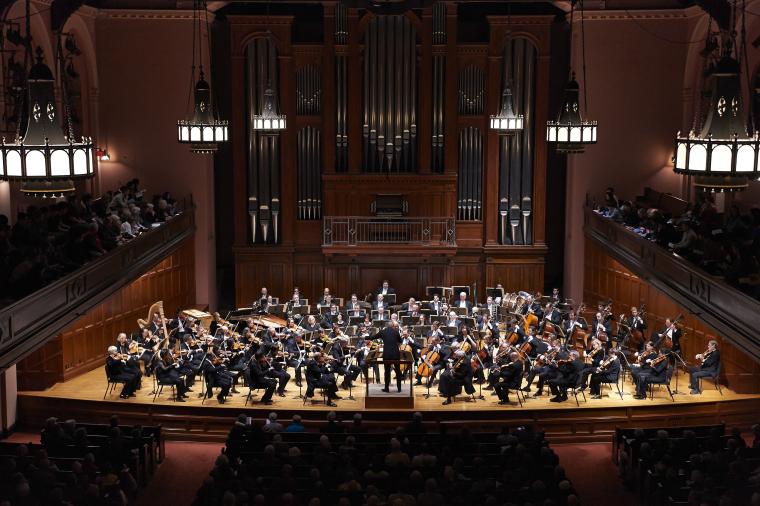Cleveland Orchestra Returns to Oberlin April 17
April 7, 2016
Erich Burnett

Oberlin and the Cleveland Orchestra share a history as old as the orchestra itself.
The internationally celebrated ensemble traces its roots to the generosity of John Long Severance, an 1885 graduate of Oberlin College who created the Musical Arts Association, under which the Cleveland Orchestra was established in 1918.
Beginning in 1919 and continuing every year since, the Cleveland Orchestra has celebrated its bond with Oberlin by performing in Finney Chapel—a tradition that numbers more than 200 concerts and counting.
That tradition continues Sunday, April 17, when the Cleveland Orchestra concludes Oberlin’s 2015-16 Artist Recital Series season with a 4 p.m. performance in Finney Chapel, under the direction of Jane Glover.
The performance will feature Haydn’s Symphony No. 6 in D Major (“Le Matin”) and two pieces by Mozart: the Concerto in C Major for Flute and Harp, K. 299 and Symphony No. 39 in E-flat Major, K. 543.
Prior to the performance, Oberlin’s 2016-17 Artist Recital Series schedule will be revealed.
Mozart’s flute and harp concerto is one of only two true double concertos he wrote—and the only piece he ever created for harp. Its featured soloists will be Joshua Smith, principal flutist for the Cleveland Orchestra, and Oberlin harp professor Yolanda Kondonassis. Frequent collaborators, Smith and Kondonassis paired up on the 2008 Telarc recording Air, for which they were nominated for a Grammy Award for Best Chamber Music Performance.
Haydn’s early Symphony No. 6, "Le Matin," known for the stunning musical sunrise that opens the work, features extended solos for virtually every instrument in the orchestra—a nod to the concerto grosso of the previous era and an acknowledgment that Prince Esterházy’s earnest new hire was completely aware of the accomplishments of the musicians in his orchestra.
Completing the program is Mozart’s Symphony No. 39. It’s widely known that Mozart composed at a breakneck speed. This work was the first in a series of three symphonies that were the last he composed. And he completed all three in about nine weeks. While No. 39 is not as well known to audiences as Nos. 40 or 41, it is distinguished in part by its relatively rare slow introduction, a memorable and boisterous minuet and trio whose melody is derived from a popular Viennese drinking song, and a single-theme finale—a fitting companion for the Haydn symphony.
Tickets for the Cleveland Orchestra’s 2016 performance at Oberlin are $35 ($30 for seniors, Oberlin staff, and alumni), and all student tickets are just $10.
For more information on the arts at Oberlin, visit the online arts guide.
Tags:
You may also like…
Contemporary Collaborations with Third Coast Percussion
April 15, 2025
“Strum,” “Strike,” and “Bend” are all evocative references to the physicality of string and percussion instruments. And one is especially significant.
Martha Redbone Hears Her Musical Call
March 18, 2025
The vocalist and songwriter brings her distinct blend of folk, blues, gospel, and more to Finney Chapel on April 6 in an appearance with the Martha Redbone Roots Project.
Oberlin Opera Brings “Jack and the Beanstalk” to Schools Across Northeast Ohio for Winter Term
March 10, 2025
“It was really amazing going into the community and performing an art form that they probably haven't seen before,” second-year voice major Ella Vaugn said, “Teachers would tell us that they've never seen their students so engaged.”


